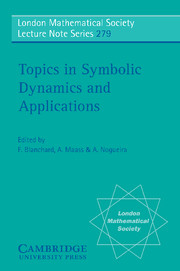Book contents
- Frontmatter
- Contents
- FOREWORD
- 1 SEQUENCES OF LOW COMPLEXITY: AUTOMATIC AND STURMIAN SEQUENCES
- 2 SUBSTITUTION SUBSHIFTS AND BRATTELI DIAGRAMS
- 3 ALGEBRAIC ASPECTS OF SYMBOLIC DYNAMICS
- 4 DYNAMICS OF ℤd ACTIONS ON MARKOV SUBGROUPS
- 5 ASYMPTOTIC LAWS FOR SYMBOLIC DYNAMICAL SYSTEMS
- 6 ERGODIC THEORY AND DIOPHANTINE PROBLEMS
- 7 NUMBER REPRESENTATION AND FINITE AUTOMATA
- 8 A NOTE ON THE TOPOLOGICAL CLASSIFICATION OF LORENZ MAPS ON THE INTERVAL
2 - SUBSTITUTION SUBSHIFTS AND BRATTELI DIAGRAMS
Published online by Cambridge University Press: 05 August 2013
- Frontmatter
- Contents
- FOREWORD
- 1 SEQUENCES OF LOW COMPLEXITY: AUTOMATIC AND STURMIAN SEQUENCES
- 2 SUBSTITUTION SUBSHIFTS AND BRATTELI DIAGRAMS
- 3 ALGEBRAIC ASPECTS OF SYMBOLIC DYNAMICS
- 4 DYNAMICS OF ℤd ACTIONS ON MARKOV SUBGROUPS
- 5 ASYMPTOTIC LAWS FOR SYMBOLIC DYNAMICAL SYSTEMS
- 6 ERGODIC THEORY AND DIOPHANTINE PROBLEMS
- 7 NUMBER REPRESENTATION AND FINITE AUTOMATA
- 8 A NOTE ON THE TOPOLOGICAL CLASSIFICATION OF LORENZ MAPS ON THE INTERVAL
Summary
Bernard HOST
Équipe d'Analyse et de Mathématiques Appliquées
Université de Marne la Vallée
2 rue de la Butte Verte
93166 Noisy le Grand cedex
France
The goal of these lectures is to introduce, through the example of substitution dynamical systems, some of the basic concepts of topological dynamics: minimality, unique ergodicity, Kakutani-Rohlin partitions, …
Moreover, we shall present here the less classical notions of Bratteli diagrams and Bratteli–Vershik systems. It became clear in the last years that these objects provide a very fruitful link between topological dynamics and the theory of C*-algebras. In particular, an algebraic invariant of C*-algebras, the so-called “dimension group”, has been proved to have a dynamical interpretation, and can now be used for the classification of dynamical systems.
Since we cannot completely develop this theory in the available space, we shall only explain how to construct a Bratteli–Vershik model in the case of substitution dynamical systems.
Subshifts
Notation: Words, Sequences, Morphisms
Words. An alphabet is a finite set of symbols called letters. If A is an alphabet, a word of A is a finite (non-empty) sequence of letters, and A+ denotes the set of words. For u = u1u2 … un ∈ A+, ∣u∣ = n is called the length of u. For each letter a we denote by ∣u∣a the number of occurrences of a in u and the vector (∣u∣a; a ∈ A) is sometimes called the composition vector of u. A* consists of A+ and the empty word ∅ of length 0.
- Type
- Chapter
- Information
- Topics in Symbolic Dynamics and Applications , pp. 35 - 56Publisher: Cambridge University PressPrint publication year: 2000
- 2
- Cited by

